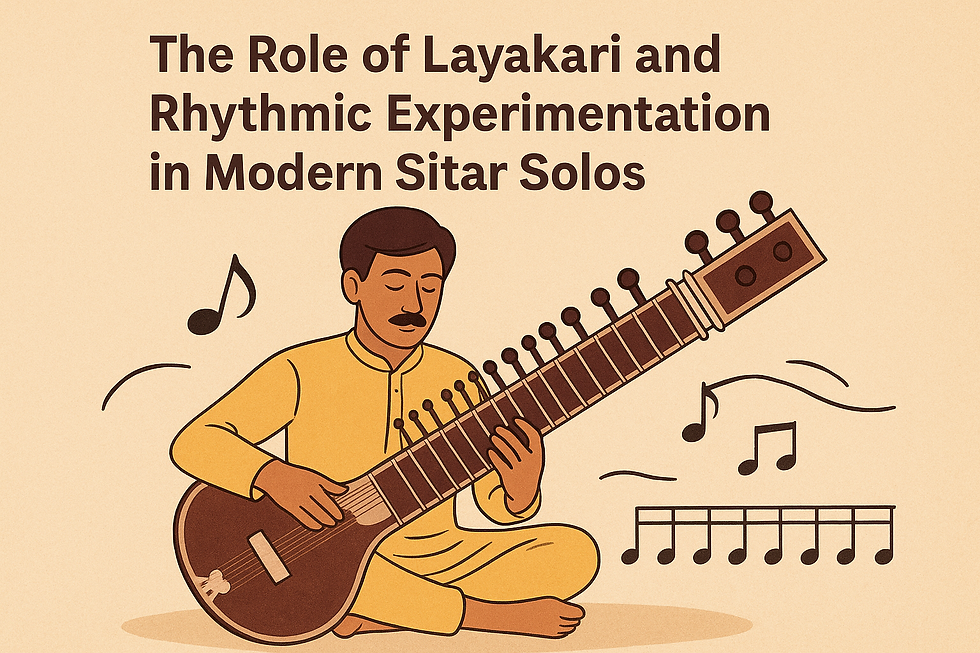Rasa & Bhava: The Sitar Master's Guide to Playing with Pure Emotion
- Sharanya naidu
- Oct 31
- 2 min read
When we think of mastering the sitar, our minds often go to perfecting meends (glides), taans (fast passages), or layakari (rhythmic intricacies). Yet, the true essence of Hindustani instrumental music lies not just in technique—but in expression. The sitar, with its rich tonal depth and resonant strings, becomes a voice of emotion when the artist transcends mechanics and reaches into the world of Rasa and Bhava.

🎵 Understanding Rasa and Bhava
In Indian aesthetics, Rasa is the flavor or emotional essence experienced by the listener, while Bhava is the emotional state or feeling expressed by the performer.
Bhava originates within the artist—an inner emotion.
Rasa arises in the listener—the shared aesthetic experience.
A sitarist’s role, therefore, is to transform personal feeling (bhava) into universal emotion (rasa) through sound.
🌺 Expressing Emotion Without Words
Unlike vocal music, instrumental performance does not rely on lyrics. Expression comes purely from tone, phrasing, and dynamics. In Hindustani sitar, these subtle devices convey emotion with remarkable depth:
Meend (glide): Creates the feeling of yearning or longing.
Gamak (oscillation): Adds energy, passion, or intensity.
Muted strokes or silences: Suggest introspection or tenderness.
Jhala (rapid strokes): Brings out excitement or joy.
Each raga carries its own emotional world—for instance, Raga Yaman evokes serenity, while Raga Darbari Kanada expresses melancholy and depth. The artist’s understanding of these moods brings bhava to life.
🎶 Technique as a Gateway, Not the Goal
It’s important for sitar learners to realize that technique serves expression—not the other way around. Mastery of fingering, rhythm, and intonation is essential, but emotion begins when the player internalizes the raga. Listening deeply to great maestros like Ravi Shankar, Vilayat Khan, or Nikhil Banerjee reveals how technical mastery blends seamlessly with emotional storytelling.
🧘 Cultivating Rasa in Practice
Here are some ways to bring Rasa and Bhava into your sitar practice:
Immerse in the Raga’s Mood – Before playing, spend time listening and feeling the emotional landscape of the raga.
Slow Alap Practice – Focus on tone and expression rather than speed. Every note should breathe.
Connect to an Inner Emotion – Play from a feeling—serenity, sadness, devotion—and let that guide your phrasing.
Silence and Space – Learn where not to play. Sometimes emotion flows from pauses.
Mindful Listening – Record and listen to your playing as a listener would. Does it evoke feeling?
🌌 The Journey Beyond Technique
When a sitarist reaches the point where notes flow like thoughts and emotions shimmer through every pluck, the music transcends mere sound. It becomes a dialogue between the artist, the raga, and the listener. In that moment, Rasa manifests—and the sitar truly speaks.
In essence, the art of playing the sitar is not only about scales and speed but about awakening emotion. Beyond the frets and strings lies a world of feeling—one that invites both player and listener into the timeless beauty of Hindustani Rasa and Bhava.



Comments